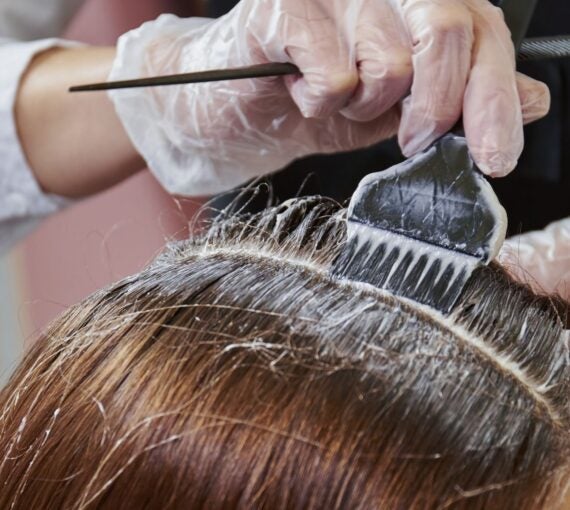
Substances in cosmetics, soap, shampoos, lotions, sunscreens and cleaning products can create and release formaldehyde.
A smell memory from science classes: the pungent aroma of formaldehyde, used to preserve dissection animals.
Formaldehyde is an organic compound that occurs in nature. It transforms into gas at room temperature.
Its mass production began in the 1880s. It’s used in manufacturing and health care for its antibacterial properties. It revolutionized construction and furniture making as an ingredient in glues, bonding agents and resins for countertops. It’s a food preservative. It’s a byproduct of cigarette smoke, vehicle exhaust and gas or wood-burning stoves. Substances in cosmetics, soaps, shampoos, lotions, sunscreens and cleaning products can create and release it.
Exposure to concentrated levels of formaldehyde can cause adverse health effects. The International Agency for Research on Cancer and the European Union say it’s a carcinogen.
Health and environmental hazards of formaldehyde-releasing preservatives
Human health risks and concerns
People exposed to high amounts of formaldehyde at work may get cancers, including nose and throat. Embalmers and medical professionals have an increased risk of myeloid leukemia. Some studies found a link between exposure and cancer of the nasopharynx.
Breathing formaldehyde fumes can cause eye, nose and throat irritation, coughing and skin allergies. Long-term exposure to low levels may cause breathing and skin conditions like eczema. A 2014 study found exposure while pregnant correlated to having a child with autism spectrum disorder. A 2015 study showed that medical students and instructors exposed in a lab had decreased pulmonary function.
Environmental risks and concerns
Formaldehyde breaks down in the atmosphere to create formic acid and carbon monoxide, which can be harmful. It can also damage the environment:
- As a volatile organic compound (something that emits gases into the air). It may react with pollutants to form ground-level ozone, contributing to smog.
- If it gets into waterways, it can affect aquatic and terrestrial ecosystems.
- Excessive emissions can impact tree growth rates and birds’ lungs.
- It’s toxic to fish, shellfish and other creatures in waterways, lakes and oceans.
Regulatory status of formaldehyde-releasing preservatives
Current regulatory status of formaldehyde-releasing preservatives in Canada
Canada lists formaldehyde as a known human carcinogen.
- Since 2023, Composite Wood Products Regulations prohibits importing, selling or offering a formaldehyde-containing composite wood product unless it meets requirements. Health Canada showed that more than 90 per cent of select composite wood products tested release it.
- Manufacturers of composite wood panels and laminated products must analyze their products and have them certified by a third party to ensure they follow emission levels. Finishings and flooring must only include certified composite wood panels and laminated products.
- The Canada Consumer Product Safety Act prohibits formaldehyde-based thermal insulation.
- Health Canada sets indoor residential guidelines for formaldehyde.
Current regulatory status of formaldehyde-releasing preservatives in other countries
- European Union. Furniture, wood-based articles or vehicle interiors emitting more than 0.062 milligrams per cubic metre of air cannot be marketed.
- United Kingdom. Classifies it as a restricted substance, due to its carcinogenic, mutagenic and acute toxicant properties.
- United States. The Environmental Protection Agency regulates it under the Clean Air Act. It’s designated as a hazardous air pollutant. The Occupational Safety and Health Administration set limits for the amount for worker exposure. This includes hair salons using commercial hair smoothing products. A product labelled “CARB Phase II Compliant” meets the acceptable level standard.
Function of formaldehyde-releasing preservatives
Formaldehyde has antimicrobial and antioxidant properties. These delay spoilage and extend shelf life while maintaining product quality. It’s used in industry and healthcare for these reasons. When dissolved in water, formaldehyde becomes formalin. Funeral homes and medical labs use it as an industrial disinfectant and preservative.
It’s in glues, bonding agents, building materials and household products:
- Particleboard, plywood and fibreboard
- Permanent press fabrics, clothing, sheets and towels
- Paper coatings, wax paper, grocery bags and wallpaper
- Insulation
- Cosmetics, shampoo, hair conditioner and bubble bath
- Tobacco products, including cigars and cigarettes.
How to avoid formaldehyde-releasing preservatives
Formaldehyde emissions can have significant impacts on human health and the environment. You can reduce them.
Does your work environment use formaldehyde? Wear adequate protective equipment. Ensure the area is well-ventilated. Employ monitoring technologies to help cut formaldehyde in the air.
What to look for on labels
Limit formaldehyde exposure in cosmetics and personal care products. Check labels for:
- Formalin
- Formic aldehyde
- Methanal
- Methyl aldehyde
- Methylene glycol
- Methylene oxide
Chemicals used as preservatives that can release formaldehyde:
- Benzylhemiformal
- 2-bromo-2-nitropropane-1,3-diol
- 5-bromo-5-nitro-1,3-dioxane
- Diazolidinyl urea
- 1,3-dimethylol-5,5-dimethylhydantoin (or DMDM hydantoin)
- Imidazolidinyl urea
- Sodium hydroxymethylglycinate
- Quaternium-15
Substitutes and alternative methods
- Use “exterior-grade” pressed-wood products. Before buying, ask the company about formaldehyde content.
- Ensure prefinished flooring complies with CARB II standards.
- Installing unfinished wood floors? Avoid “acid-cured.” It contains high levels of formaldehyde.
- Never run car or lawnmower engines in an attached garage or workshop or near windows or entrances.
- Never smoke tobacco products inside.
- Ensure proper home ventilation.



